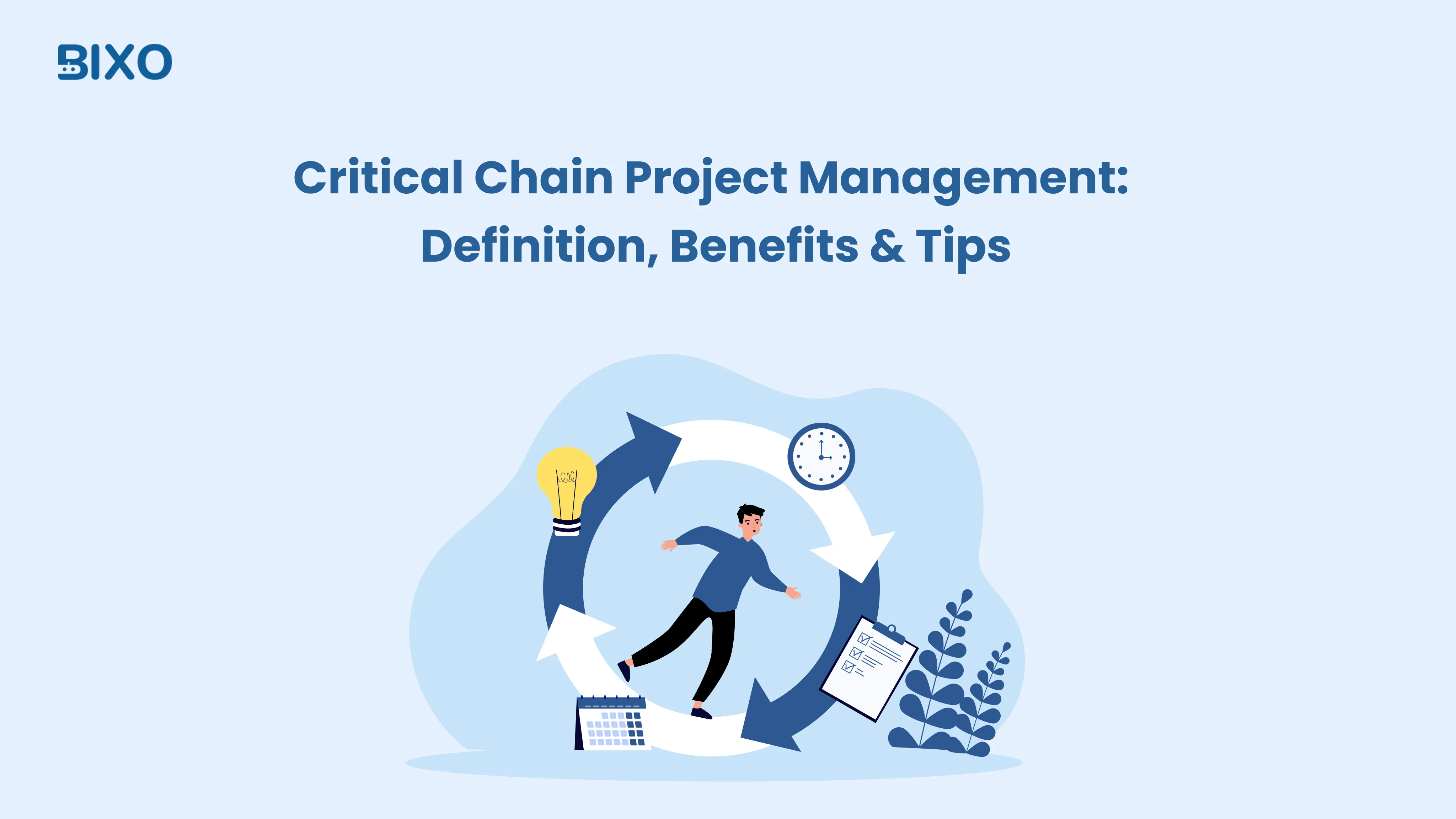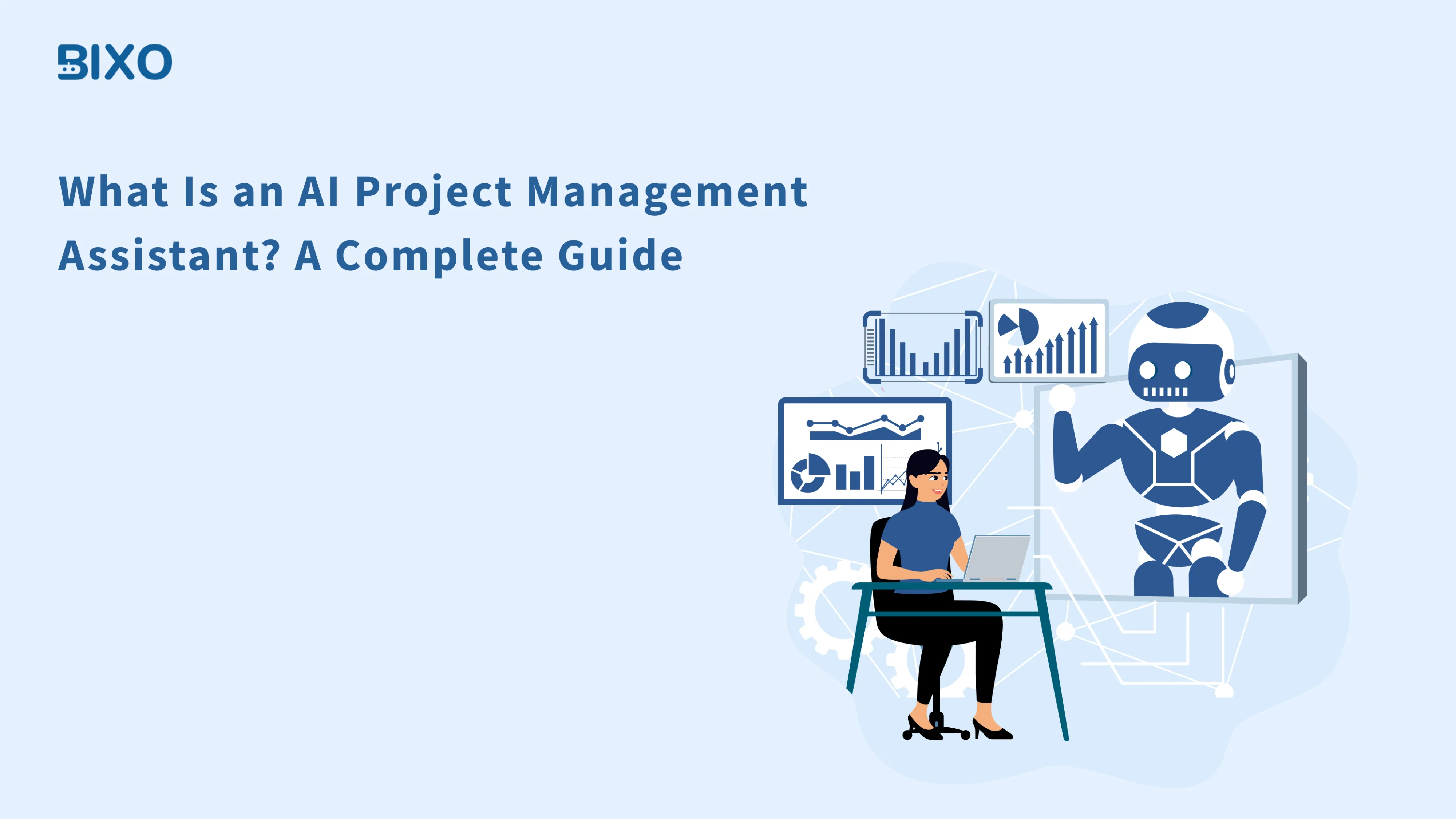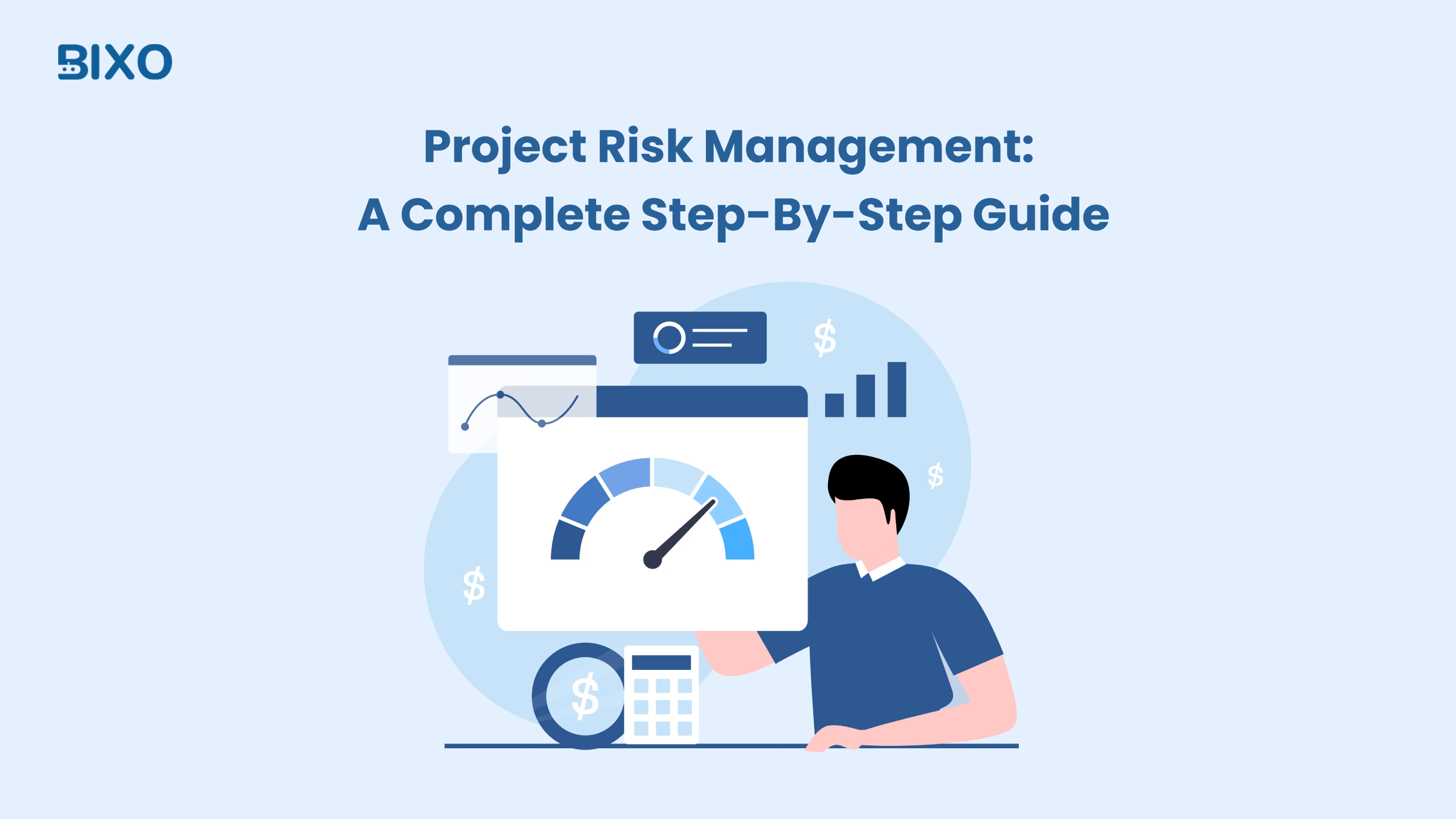
Table of Content
Focus on what matters. BIXO handles the rest!

Every project comes with unexpected problems, and without proper planning, even small issues can become big risks, which is why project risk management helps. The earlier you spot and manage these risks, the more you can keep your project on track and eliminate challenges. By understanding project risk management, you can take control of your project issues in the early stages.
In this guide, you will learn about the project risk management process and understand different types of risks in project management. By the end, you will feel confident in spotting risks early and keeping your projects running smoothly.
What Is Project Risk Management?
Project risk management is the process of spotting, understanding, and handling risks that might affect your project's success. In simple terms, it helps you think in advance about risks that may cause trouble for your project. When you manage these risks in advance, you can reduce issues and make sure your project runs more smoothly.
A risk might be a challenge, such as losing funds, or a benefit, like gaining extra resources. By using the right project risk management methods, you can make smarter choices, stay in control, and guide your team with confidence.
Why Is Project Risk Management Important?
Project risk management is an important key that keeps your projects on track and successful. By identifying, evaluating, and handling risks early, you can ensure that there will be no last-minute issues in your project. Knowing the importance of project risk management plan can lead you to make better decisions and enhance project performance.
- Reduces Project Failures : By effectively managing project risks, the chance of project failure is minimised. The project risk management process helps you to reduce unexpected issues, such as delays, technical problems, or shortages of resources. You will be able to keep your project on track by identifying risks early and planning for responses in advance. This will help you to avoid smaller issues that turn into major failures in the future.
- Improves Decision-Making : Being aware of possible risks will enable you to make better decisions during your project. Having clear information on challenges and opportunities makes managing project risks smarter and more confident. When you are aware of these risks, you can select risk strategies that will keep your project on track. This will minimise the uncertainty and simplify your everyday decisions, making them easier and more effective.
- Optimises Resource Allocation : Appropriate risk management enables you to utilise your resources better. The process of project risk management allows you to allocate team resources, time and money to where they are most required without wasting effort. When you prepare for problems, you can make sure your resources are used wisely and don’t get wasted on avoidable issues. This makes your project efficient and well organised.
- Enhances Stakeholder Confidence : When risks are managed effectively, everyone who is involved in your project feels more confident. Stakeholders, your team, clients, or sponsors, trust your plans and decisions in project risk management methods. This trust encourages better team communication and support, making it easier to get approvals, funding, or collaboration when needed. Your project becomes more reliable in everyone's eyes.
- Increases Project Resilience : Managing risks strengthens your project’s ability to handle any challenges. Even if unexpected problems occur, having backup plans in advance ensures your project runs smoothly. Managing project risks makes your project more flexible and prepared for any issues. With resilience, your team can face obstacles without any pressure, and you can respond to changes quickly, keeping the project moving forward and achieving your goals.
What Are the Different Types of Project Risk Management?
When you work on a project, risks can come from many directions. Understanding the different types of risks in project management helps you to prepare for challenges and take advantage of opportunities that might help your project be completed.
Negative Risks (Threats)
Negative risks are the problems that slow down your project. For example, missed deadlines, lower budgets, or poor-quality deliverables. When you recognise these threats in an early stage, the project risk management process can assist you in reducing the impact of these threats before they turn into major issues.
Handling threats does not mean removing them completely, but managing them smartly. You may adjust your schedule, reassign resources, or build backup plans. This will keep you prepared to take on the challenges without losing control of your project.
Positive Risks (Opportunities)
Not all risks are bad, and some can bring good results. These are called positive risks or opportunities. These risks may help your project to finish earlier, save costs, or add extra value. With the right project risk management methods, you can turn these chances into benefits.
For example, finding a faster tool or getting extra funding are opportunities for the project. By planning for these positive risks, you will get the most unexpected benefits while still keeping your project stable.
Financial Risks
Financial risks affect your project budget and funding. These could include rising costs, lower profits, or a lack of resources. By properly managing project risks, you can predict these financial issues and develop measures that will help you manage the project within budget.
Technical Risks
Technical risks are related to tools, systems or technology in your project. For example, software bugs, hardware failures, or integration problems. The project risk management process assists you in testing and tracking these technical components in advance, before they cause more trouble to your project.
You can reduce these technical risks by checking up on the systems regularly and preparing backup solutions. This helps your project run more smoothly and avoids delays caused by technical failures.
Operational Risks
Operational risks occur in the day-to-day business. These involve team mistakes, ineffective communication, or work delays. If you fail to manage these operational problems, it may impact the project quality and timelines.
Good project risk management implies better workflows, assigning clear roles, and team lead. This helps in minimising mistakes, wasting time and maintaining the smooth running of the operations.
External Risks
External risks impact things outside of your project, like new regulations or issues with supplies or market changes. Such risks cannot be directly managed, but through project risk management, you will be able to reduce the impact in advance.
One way to manage these risks is to monitor trends, maintain backup suppliers and be aware of the rules and regulations. The right project risk management methods can help you keep your project on track even when external factors cause problems.
How to Start Managing Project Risks Effectively?
Managing project risks is most effective when it becomes a daily routine, not just a one-time effort. The better you prepare and the more you understand, the easier it is to solve problems at an early stage before they can turn into bigger issues. Consider developing small habits such as discussing risk, checking regularly, and being flexible. These practices will strengthen your project and also boost the confidence of your team.
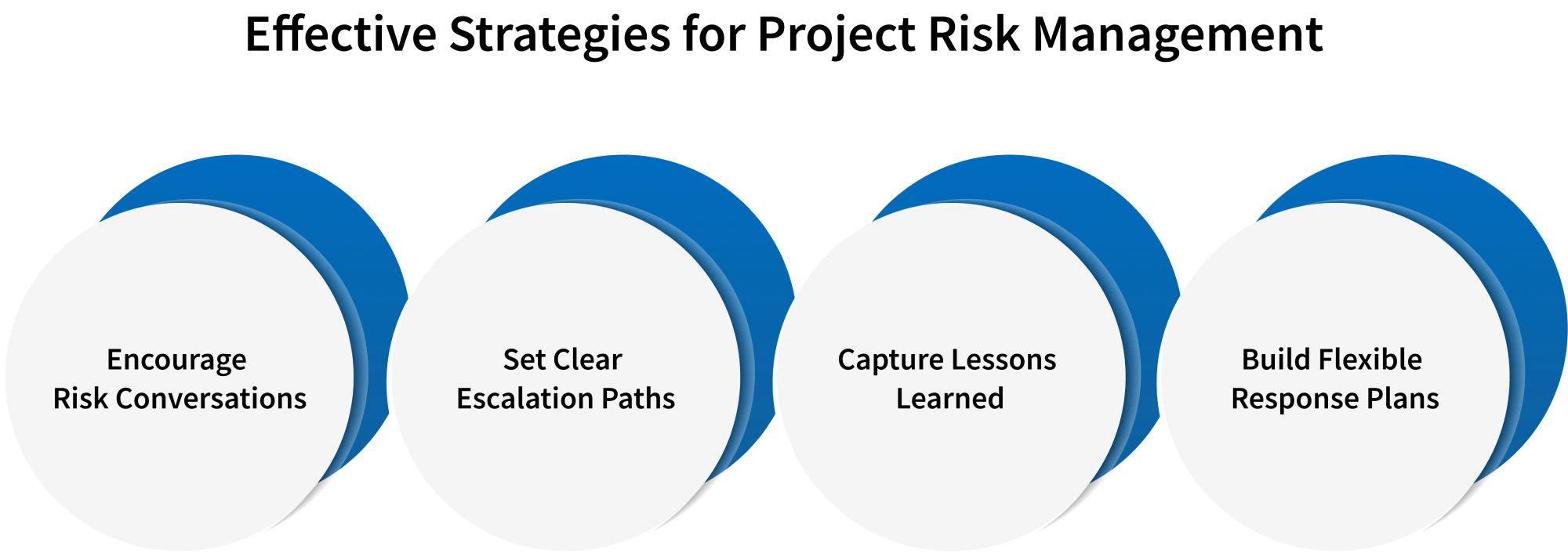
Encourage Risk Conversations
If your team encourages talking about risks, you will catch problems early. When people stay quiet, small issues can turn into big troubles later. Creating space for open talks keeps everyone honest and prepared. This simple step in managing project risks will build trust among the team. The more your team shares, the easier it is to work together on fixing risks before the issues slow the entire project.
Conduct Risk Review Meetings
Quick check-ins about risks can save you from unexpected problems. These meetings don’t need to be long; they are just an opportunity for the team to share updates about new risks. Regular communication keeps risks from causing delays for the project. By adding these reviews to your project risk management process, you can make smarter choices and stay one step ahead. Everyone knows what’s happening in the project, and no risk gets ignored.
Set Clear Escalation Paths
Sometimes a risk is too big for one person to handle alone. That’s where clear escalation paths help. Your team should know exactly who can solve the issue faster when a serious risk shows up. This makes managing project risks smoother. Instead of wasting time figuring out what to do, with these clear escalation paths, the problem quickly moves to the right person who can take action and solve the issue.
Capture Lessons Learned
Each project will teach you something new about risks. When you write down what worked and what did not work, then you can have a guideline to use in your next project to solve any risks when they occur. This saves time and helps you to avoid mistakes. By adding the less you have learned in project risk management methods, you will gain new ideas that can help you in the future. It is like creating a roadmap to simplify every project.
Build Flexible Response Plans
Not all risks can be predicted, but you can still stay ready when a risk occurs. Flexible response plans mean you will always have a backup option. If one plan fails, you will already have another plan to solve the issue. This approach strengthens your project risk management process. It keeps your team calm and ready to adapt, even when something unexpected happens in your project.
What are the Challenges in Project Risk Management Process & How to Handle?
Managing risks in projects is not always smooth because unexpected challenges often occur. Problems like unclear goals, missed deadlines, or poor communication and many more, can slow down the process. Knowing these challenges early helps you improve your project risk management process.

Scope Creep
Scope creep occurs when additional tasks or features are added to a project without proper planning. It extends your timeline and resources, making your project hard to control. In project management risk examples, scope creep is one of the most common challenges. Staying clear about goals and having strong change control methods can avoid this scope creep.
Budget Creep
Budget creep happens when costs gradually increase more than what you have planned. This can happen from price increases, poor tracking, or unexpected changes. Even a small increase in budget can slow down the whole process. Good project risk management methods, like tracking expenses regularly and reviewing budgets with your team, can prevent budget creep from becoming a bigger issue in the future.
Communication Breakdowns
When there is a communication breakdown within your team, the risks are not identified or shared at the correct time. Misunderstandings between teams can simply slow the progress. Effective project risk management includes strong communication, regular updating, daily reporting, and clear discussions between the teams to make sure that everyone knows about what is happening and what to do if a risk occurs.
Lack of Clarity in Requirements
If project requirements are not clear, risks appear from the early stage of the project. Confusion about what requirements are needed can cause delays, rework, or even project failure. One of the best ways to handle this is to clarify the questions early and confirm the requirements that are needed for the project. This step makes the project risk management process smoother and delivers the project faster.
Poor Scheduling
Poor scheduling can create big risks for deadlines and resources. If tasks aren’t planned well in the early stage, your team may face overwork or delays in progress. Using simple project risk management methods, like setting realistic timelines and tracking progress daily, helps you to stay on track and avoid poor scheduling problems in the project.
Which Best Practices are Useful for Effective Project Risk Management?
Best practices in project risk management make it easier to handle risks smoothly and keep your projects moving forward. These practices help you to stay prepared, reduce stress, and avoid last-minute issues.
Here are five useful best practices:
- Make risk management your daily routine in project work.
- Keep communication open and clear with your team to solve any issues quickly.
- Use simple project risk management methods like risk logs or checklists.
- Involve your team in spotting and sharing risks in the project early.
- Stay flexible so you can adjust quickly when risks change.
Spot Your Project Risks Early Using BIXO
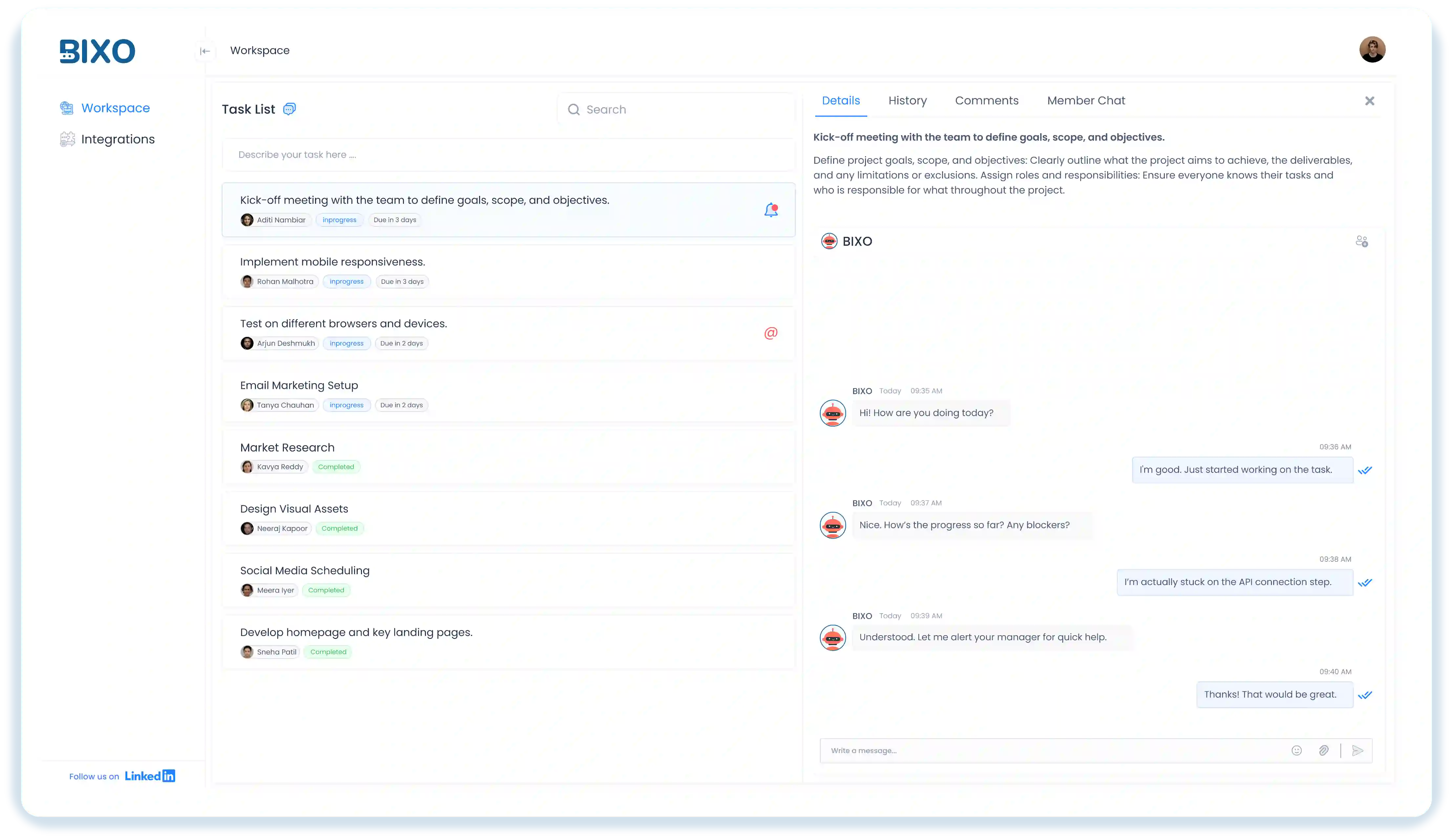
Identifying risks at the right time can make the difference between a project that succeeds and one that struggles. BIXO helps you spot potential issues early by monitoring progress, tracking deadlines , and analysing task patterns in real time. It gives you a clear view of where delays, resource gaps, or workload imbalances might occur before they turn into bigger problems. With smart alerts and automated updates, you stay informed without needing constant check-ins. BIXO ensures you have the insights to take timely action, reduce uncertainty, and keep your projects running smoothly from start to finish.
Conclusion
Project risk management is not about avoiding the issues completely, but it is about being ready when a risk occurs. When you plan, track, and respond to risks early, projects run with less stress and more control. Tools like BIXO make this process simpler by helping you spot risks on time and manage them effectively. With the right steps, you can turn risks into opportunities for smoother project success.
FAQs
You can spot the risks by reviewing your project plan, communicating with your team, analysing older projects, and using tools like BIXO to track issues early. Regular check-ins make sure that no risks are missed.
Project risk management can’t eliminate every risk, but it helps you to spot issues early and take action. This reduces surprises, avoids delays, and increases the chances of project success.
You should review the risks regularly or at least weekly. With the help of tools like BIXO, you can track risks easily and make sure nothing is missed, and it will also help your team stay ready when a risk occurs.
Not at all. Every project, even if it is big or small, can face risks during the process. Using the right project risk management methods and tools, like BIXO, ensures you stay prepared when risks occur, no matter what the project size. .
Get a demo of BIXO
Recommended Blogs
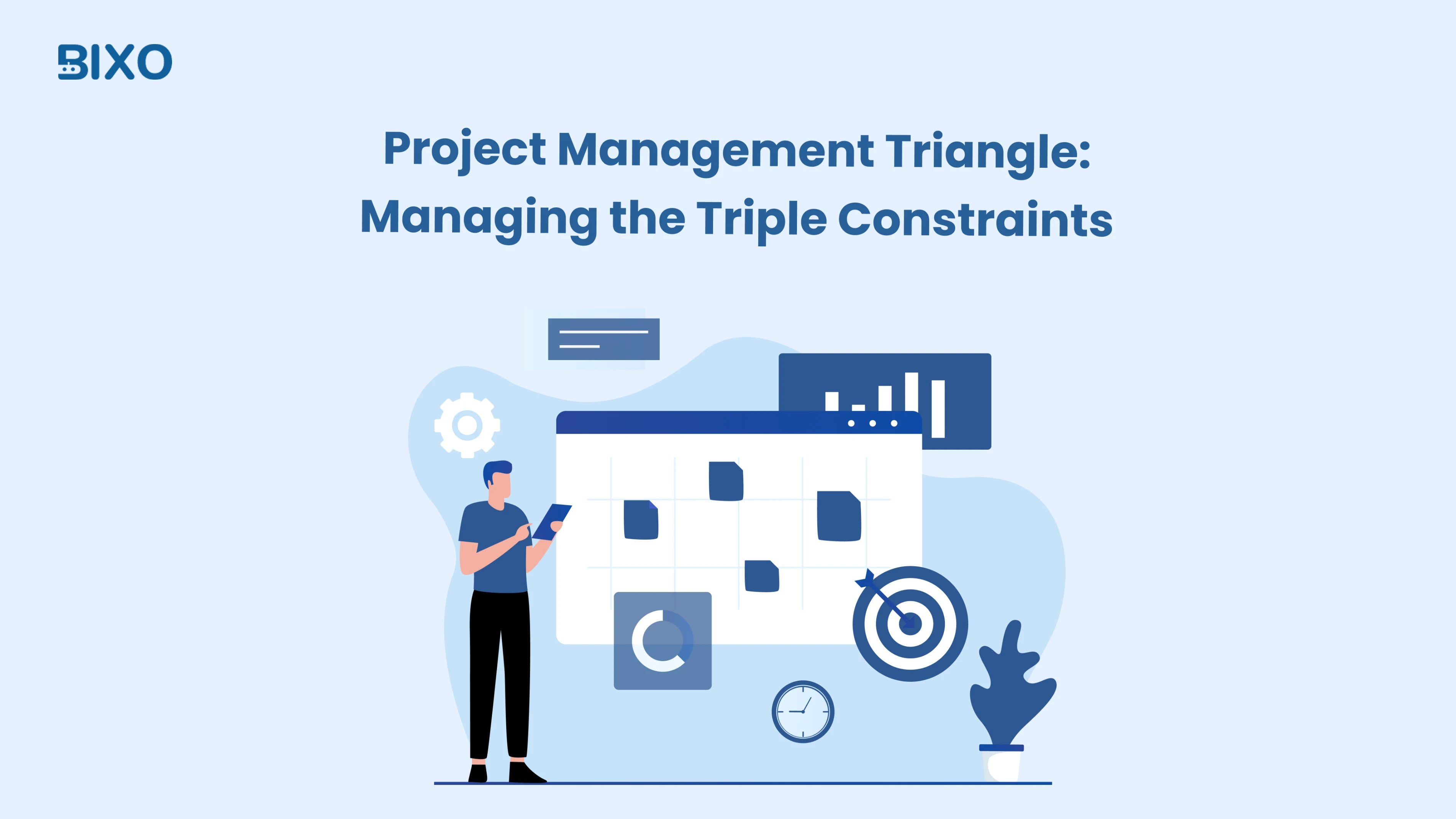
Project Management Triangle: Managing the Triple Constraints
Master the project management triangle by balancing scope, cost, and time with simple strategies that drive successful outcomes every time.
 Jahnavi Chintakrindhi |
Jahnavi Chintakrindhi |
 Oct 13, 2025
Oct 13, 2025

